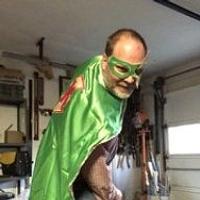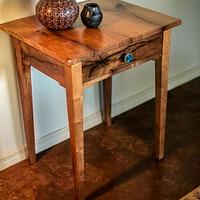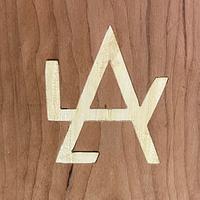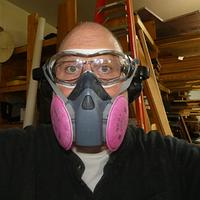
GeorgeWest
in about 3 years
Table saw sleds, How 5 cut do you need to be?
So do you need to be as tight as William directs you to be? How much time and effort should you put into it? Is using a good quality square good enough to get you there?
Tell me what ya think. Show us what you have built or done to add perfection to your sleds.
I also love Jonathan Katz-Moses. He picks a thought about something, and then goes out and rents, or buys space age equipment to literally show you what he is talking about. His recent video on sled squareness will become the new William Ng's 5 cuts to a "Perfect" Crosscut Sled
Check Jonathan out here,
Please discuss. I see questions, but I couldn't find a sled thread. Huh, kinda cool a sled thread.... It has a ring to it.
66 Replies
working with my hands is a joy,it gives me a sense of fulfillment,somthing so many seek and so few find.-SAM MALOOF.
I also tend to use manufactured miter runners for jigs now. They’re adjustable and don’t swell or shrink.
Ryan/// ~sigh~ I blew up another bowl. Moke told me "I made the inside bigger than the outside".
working with my hands is a joy,it gives me a sense of fulfillment,somthing so many seek and so few find.-SAM MALOOF.
On a 45* sled I made on the cheap for my Right tilting General 350 I bought a pair on Amazon, Chinese made, Aluminum, fully adjustable, ball bearing, and measured at 300 MM. They were cheeep, and actually worked quite well. I loved the name, Estink. I laughed about that for a while. The Zon must have been selling a bunch of them, they got to me next day, even though they said 2, 3 days. I would seriously buy them again. Beside price I don't see anything between them and the MicroJig sliders. Actually the MicroJig are flimsy until they are mounted, these were rigid, and quite easy to use.
The last quick jig I did was my 1/4" finger joint jig, and I cut out some QS WO and fit them using a shooting board, they remained stable and slick through all 4 seasons. Just only over a year old, so long term hasn't been decided.
Those look exactly like the Incra bars except in aluminum, though the zoo says aluminum alloy and then says stainless steel). Don't see any form of ball bearings, just the expanding nylon washers.
I haven't looked for slides in eons, surprised at the variety now available.
My wider-than-standard Unisaw is unable to best use the design as the adjustment range (of the Incra) is not enough, but these appear to be a decent and inexpensive way to make some jigs that fit a slot without the usual headaches and expense of other aftermarket stuff.
Yean, they really aren't stinky at all.... :-)
Both my General, and my contractor Delta have a standard 3/8 x 3/4 slot, but both are a sloppy 3/4" so the adjustable feature is a good thing.
How precise should you dial it in when you make it? Well, as you said, over time it's only going to get worse. So I say as precise as you possibly can. Regarding sleds specifically, the 5-cut method is a sound one IMO and a method that most woodworkers can use with measuring tools they already have. I'll go with the supposition that (a) the blade is set dead parallel to the miter slots and remains that way and (b) the sled fence is dead flat and can't move and (c) the miter runner is locked in solid and can't move and is consistently tight through the entire cut in the slot.
Let me back up a bit... In mechanical design, we use a principle called exact constraints. What this basically means is that you control a design by making sure that no components are over or under constrained. Applying this to a table saw sled, you have 6 degrees of freedom to consider:
- moving vertically (up-down)
- moving laterally (side-to-side)
- moving longitudinally (front-to-back)
- rotation around lateral axis (back or front lifts)
- rotation about longitudinal axis (left or right lifts)
- rotation about vertical axis (spins l/r on the table)
- moving vertically (up-down) Generally gravity will take care of this unless the sled is so light that the blade is able to lift it in which case we have to find another method.
- moving laterally (side-to-side) For a sled this is generally done by using a miter bar engaged in the slot in the table but could also be done by straddling the fence or by something more elaborate like a sliding table found on some saws.
- moving longitudinally (front-to-back) We obviously need to allow motion in this direction unless our blade can move through the work instead of the work moving through the blade. For a table saw, we'll assume we want full free motion in this direction.
- rotation around lateral axis (back or front lifts) Provided our sled is fully supported by the table and #1 is fixed, the table and gravity will take care of this.
- rotation about longitudinal axis (left or right lifts) Same as #4.
- rotation about vertical axis (spins l/r on the table) The miter slider engaged with the miter slot will constrain this DOF in theory but there is more to consider.
Let's assume our sled is heavy enough that it's unable to lift off the table. So the weight of our sled constrains #1.
#2 is a little trickier. Our miter slider has to stay engaged with the slot through the full cut for us to get the results we want. No problem keeping the bar IN the slot right? As long as the bar is at least as long as the sled, we're good. BUT, from experience I can say that it may not be that simple. My miter slot on the right side of my table is pretty worn and measures several thousandths of an inch wider in the center than it does at the front and back of the table. So in order for my slider to constrain the sled against motion, it not only has to be IN the slot but it has to engage the slot fully through the full range of motion. So on my saw, that can't be done with a simple bar (I'm not even going to get into sliding fit tolerances in this particular diatribe) because if I use a bar that can slide freely through the infeed and outfeed sides at the front and back of the table, it will be "sloppy" in the center of the slot and the sled could shift while the work is in the cut. So what's a girl to do? There are some options:
- Use a miter slider like George mentioned previously with UHMW washers that expand is my personal choice. These elastic washers allow me to tighten screws to expand the washers to engage my slot fully in the wider center section but are elastic enough that I can push them through the front and rear of the slot with some resistance. "Some" resistance means that I haven't technically constrained the sled against #2 but I can still get the range of motion that I need and I can accomplish it with a readily available product.
- If we have a slot that is wider in some parts than others, eliminating #2 could be as simple as using the other slot (assuming you have one)
- But what if you do have two slots and they both have inconsistent widths? In this case you have an option of seeing if one side of your slot(s) are flat along the full length of the table. Let's say either the inside or outside edges flat on both slots. The you can use two miter sliders like pottz used above. If the inside slots are flat, you use bars that are narrower than the "tightest" sections of your slots and engage only one side, the flat one. So if your inside edges of both slots are flat, your two sliders will engage ONLY those edges. And it must be both inside or both outside edges otherwise you can still have motion side-to-side. And note that the edges must not only be flat but must also be perfectly parallel to each other otherwise you will either bind up or get sloppy at some point.
- "But Kenny, I have two un-worn miter slots that are perfectly parallel to each other so I should use two sliders that fully engage the slots, right?" WRONG! This is something I often see on sleds that makes me cringe - two adjustable miter sliders. We are looking for EXACT constraints. If you have one perfect miter slot and one slider that engages it fully (assuming you attached it rigidly to your sled) you have completely eliminated the possibility of side-to-side motion of the sled on the table. So when folks add a second slider, they see added security. I see OVER constraint. Each degree of freedom must be EXACTLY constrained otherwise our "added security" is a liability. We now unnecessarily designed in the possibility of other problems like binding to occur. If you have two slider that fully engage both slots, what happens when cold weather causes your table to contract (yes, cast iron most definitely expands and contracts with temperature)? Yes, the possibility that it will be cold enough in your shop for the table to contract and cause binding of the sliders is remote and yes, you can probably get by with two sliders with no problems. But WHY when only one will eliminate the freedom of movement you're trying to eliminate? EXACT CONSTRAINTS. Anything less is under constrained and anything more is over constrained even if it seems like a good idea.
- And there are other options. But I think I've said enough on this particular issue. If you do have the problem with sloppy miter slots though, feel free to PM me some specifics. I'd be happy to explore the design with you.
#3, as we said, is a DOF we want to retain. We want our sled to slide front to back freely and unconstrained.
#4 is in most cases constrained by the table and gravity like #1. Special cases may exist for very large sleds that aren't fully supported by the table during the full cut and can "tip" off the table either at the infeed or outfeed of the cut. Most of us would solve that by using either temporary or permanent infeed/outfeed additions to the saw. As far as the sled itself goes, most of us have "T" miter slots with wider sections at the bottom. Adding washers to the bottom of the slider that will engage the bottom portion of the slot can prevent rotation in this direction. But they should only engage the top/bottom of the wider part of the miter slot. If they engage the sides as well, we have committed a faux pas and over constrained #2 again!
#5 is again not a big issue in most cases unless you have a really big sled and a really small table. If your sled is fully supported by the table, gravity takes care of this.
#6 ties in with #2. Same basic resolution of the latter will prevent the former assuming your slider(s) are rigidly attached to the sled.
So there is a birdseye view of the Principle of Exact Constraints and how it can be applied to something like a table saw sled. We could dive much deeper of course and go into material selections, thermal considerations, sliding fit tolerances and if we really wanted to dig in, we would need to consider the design and tolerance of the flatness of the saw table, how the arbor is constrained to run true and stuff like surface finishes and hardness of the table and miter slots. So feel free to expound if you wish 😁
I started out using a sled when I first got my saw. I didn't have a miter gauge and it was the best way for me to get accurate cuts. Then, like Ryan, I got my Incra miter gauge and shortly after decided I was tired of storing my sled and to the dump it went. So my general methods have changed and there are times I have wished I still had the sled like for really small or really large pieces. But I haven't ever wished hard enough I wanted to store another one. I will say that the sled stayed really accurate for several years. I built adjustability into my fence when I made it because that's what always seems to go bad for me with wood jigs, the squareness.
working with my hands is a joy,it gives me a sense of fulfillment,somthing so many seek and so few find.-SAM MALOOF.
I'm like Larry and for a "sled" I prefer the use of both slots. I suppose it makes things a little harder to get right, but in my mind a Miter gauge is just one slot, but it's principle problem is probably the rotation, or potential to lift and move that way. With a sled and using both slots I feel it is much more grounded, and once you do get it moving freely, but not sloppily you have a sled that can bring greater accuracy, plus carry larger pieces. My poor mans sliding table.... :-)
Saying this, my way of checking results is to use my trusty Starrett and placing it on each corner check to make sure I'm not seeing any daylight. I guarantee you use a much more thorough checking which is more like the 5 cut result.
Because at the end of the day, you have that "Wood moves" thing I referred to earlier, I find that my way is fine, and after you put all the pieces together if it sits flat, and doesn't have gaps all over I'm good with the result.
Plus my average time spent on any jig or sled is less than 30 minutes if I am able to do it that quickly. I guess I'm not looking for pretty, just helpful. My principle operating theory (when it pertains to shop fixtures, cabinets, whatever) is Life is too short....
Too short to worry about...
Too short to spend time on....
on and on.
I see a lot of makers that have Walnut cabinets, beautiful, but I'd rather spend the resource, and time for something that will live inside the house, not out in the shop where there is always a fine layer of dust, and everything gets beat to he!! and back. Different strokes for different folks kinda thing. But shop stuff s not something I will use expensive resources, or time to make. It's as if the shop stuff is the goal. My brain doesn't work that way. I don't think either way is wrong, it's just what floats a persons boat, ya got to be happy with what you are doing.
Now with your view that you want to make it as accurate as you can. I have always said if the machine is set up to 0.001 kinda standards than you can only blames yourself if the cuts are dodgy, and I still try to do just that. but just on metal machines. I feel the differences between wood, and metal are metal set up's will stay put a lot better than wooden ones. Thoughts like screws wallowing out, and becoming loose, things like that. Screws and bolts on metal could potentially loosen too, but a dab of reversible locktite can go a long way toward holding them tight.
I guess I mirror my Dad, and Uncle's thoughts about same, probably most of us pick that kind of stuff up as we grow up.
Probably a Pschy person would say, these are some troubled doods. LMAO..
I know my two miter slots are different from each other owing to wear on an old saw. That said, my trunion is true and the blade runs parallel, so my jigs and setups seem to work pretty well from a precision standpoint.
Having a little (and just a little) metal working experience, I concur with Kenny. I spend a lot of time dialing in my chineseum mill and lathe, down to the thou. They do fine for the work I do, but it becomes obvious how much more pressure is being forced on the metal working tools trying to engage the project.
‘Flex’ is a real thing and it’ll show up in (my) finished projects if I’m not careful. That’s why real metalworking tools are super beefy. But it also brings an interesting ‘workshop premise’ to light that I think any woodworker needs to think about: understand not only the design limits, but also the practical functional limits of your wood working tools.
That doesn’t mean you have to have all the numbers at hand, but understanding how hard you can (vs should) push a machine will certainly affect your outcome. I was just reading something about bandsaw drift, which I think is a perfect example of this. A properly set up and used bandsaw of reasonable quality does not drift! Improperly set up wheels and tires, improperly tensioned blades, dull (improper) blades, improper tooth count, or improper feed rate will cause drift.
I certainly needed a lesson on feed rate early on, and I think a lot of guys do. You wanna make your head spin, read a good article on chip load and feed rate for end mills. 😳 But, once you start to understand the limits and range of your tools, you can turn out great stuff.
It’s arguable (I’d say I agree with it) that larger, heavier, more ‘professional’ tools will make all this a little easier. Specifically because of their build quality and (usually) mass, they’re less likely to lose their settings once dialed in, and they’re less likely to suffer from being under powered (which leads a novice to over-feed). That’s not to say a professional machine makes a novice’s work turn out like a pro’s, but it does take some of the variables out of the equation. And I need as few variables to contend with as I can get!!
What’s the saying about a professional is just better at knowing how to correct their mistakes? I’d also argue a professional has a better understanding of his machines and how to get the best out of them.
All this to say that building on simple, accurate benchmarks when making a jig is probably the best way to get an accurate jig. Aim small, miss small.
Ryan/// ~sigh~ I blew up another bowl. Moke told me "I made the inside bigger than the outside".
Pics below to show what I mean here, in case the words didn't do it.
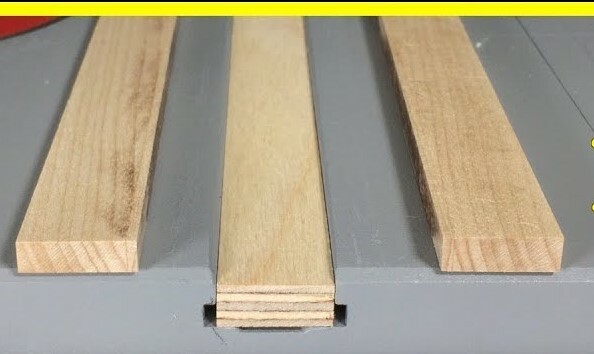
Any of the above runners could work. The plywood slice is "Dimensionally stable" so it shouldn't move. I don't suggest it's use on a runner though as my experience shows a much higher likelihood of delamination on very small slices of plywood, so while it may seem stable, it, with the addition of screws will likely delaminate. Both of the other pieces are heavily rift sawn pieces, and likely won't have much movement side to side. So again the taller, or shorter sled won't effect operation, except for needing more blade height. True QS would be better IMHO though.

Probably will work fine
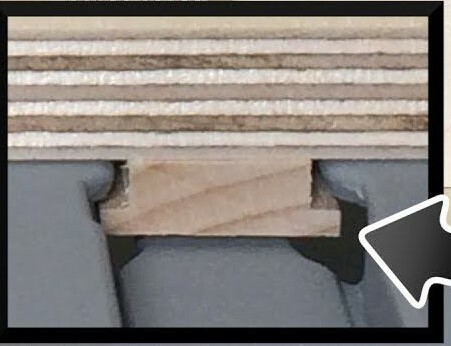
IF you have a slotted miter slot, that is used as a safety feature to prevent tipping of the gauge, or a sled. I wouldn't ever suggest trying to fill the lower slotted portion with wood, even QS. Instead make the QS runner just to fit the upper portion of the slot, and if you wanted the safety feature of using the lower slot, then screw a washer to the bottom of the runner, so it engages the wider slot. You will have an easier time of it that way.
My thoughts on this and 75 cents may get you a weak cup of coffee at a diner.
working with my hands is a joy,it gives me a sense of fulfillment,somthing so many seek and so few find.-SAM MALOOF.
Half of what we read or hear about finishing is right. We just don’t know which half! — Bob Flexner
EDIT to add: It seems to me that there may be 2 more constraints to consider which may be special cases or use cases perhaps.
First, when cross cutting really long pieces, the weight of the unsupported end can make a cross cut difficult because the supported end with tend to pivot upwards. With a miter gauge, this can be difficult to achieve but with my sled, I can use a clamp on the fence to help hold down the short end.
The second thing is eliminating issues that friction between the piece and the table can cause, like the unsupported cut off mentioned above. A sled eliminates this by pushing both sides of the cut completely past the leading edge of the blade.
--Nathan, TX. Hire the lazy man. He may not do as much work but that's because he will find a better way.
If your runners do extend out front as Kenny suggested, they would engage the T slot and while not being hands free kind of stable, will let the T help hold the sled when pretty much fully withdrawn.
Internet maker Izzy Swan has 2 different items he markets that will help with sled or wide stock support even if you lack a T slot.
Saw mounted support leg. He calls it the "Large material folding table saw infeed" The page has a video showing it being set up, and in use. You could opt to get his plan, or look at it and roll your own.
Also saw mounted is a small extension support he calls the Table Saw infeed saddle Here he offers to sell you the saddle, but again watching the video you could suss out enough knowledge to pretty easily roll your own.
I never know with Izzy if he has the original thought, or if he is a great copier of ideas?
Hi Rich. this is why I will always use QS WO, or Hard Maple, both will move very little, if at all. You will see that tangential movement a lot more with softer woods of the hardwoods, and almost all of the softwoods.
Good to point out though, as wood choice here will effect result greatly
I think those forefather guys heading West all those years ago, and their predecessors who in Europe, and elsewhere used and tried all manner of trees for different jobs to figure out which were the best performers. I imagine a lot of trial and error went into that knowledge base.
Maybe the biggest reason I like the Wood Database so much. Each listing for every species/variant has a section showing what it is good for as far as uses. Strengths, and weaknesses so to speak.
WO
Likely you won't find a wood listing saying makes killer table saw sled runners, but if a wood is listed as being strong in the flooring market, then it will be stable as a runner. Especially if a QS section is used, and correctly positioned.
Nathan, you're right about the downsides of a miter gauge. I have trouble with longer pieces using mine which is precisely what prompted me to finally make a shooting board. I'd disagree about the friction issue being a problem for miter gauges though. More surface area=more drag from friction. And unless your Dr. Who, your work has to be smaller than your sled 😉 But I agree that friction is a concern in general. I think in both cases, sled and miter gauge, the greatest source of friction is in the miter slot/runner. At least on my table saw. I wish all saw makers would standardize miter slots as dovetails. When I had my sled, I put formica on the bottom side and that worked great.
If you go to my project on the bad place, you'll see I built it with two hardwood runners. I eventually replaced them with a single adjustable runner.












